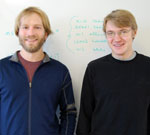Recent News
UNM Engineering team wins ASEE best paper for work on first-year engineering course
July 17, 2025
New director will enhance interdisciplinary engineering learning opportunities
July 2, 2025
Final SIRI cohort visits UNM campus
June 30, 2025
Perfetti receives ANS Landis Engineering Achievement Award
June 26, 2025
News Archives
UNM CS Team Publishes First Steps to Drug Delivery Using Molecular Spiders
March 4, 2011
 Darko Stefanovic, associate professor of computer science, and computer science PhD students Mark Olah (left) and Oleg Semenov (right) use mathematical and chemical models to explore how molecular spiders move. Working with collaborators at Arizona State and Columbia, Stefanovic and his students attach four strands of DNA enzymes as "legs" on a single molecule to create a molecular walker or "spider." When the spider is placed on a surface coated with a substrate that is complementary to the DNA legs, it moves.
Darko Stefanovic, associate professor of computer science, and computer science PhD students Mark Olah (left) and Oleg Semenov (right) use mathematical and chemical models to explore how molecular spiders move. Working with collaborators at Arizona State and Columbia, Stefanovic and his students attach four strands of DNA enzymes as "legs" on a single molecule to create a molecular walker or "spider." When the spider is placed on a surface coated with a substrate that is complementary to the DNA legs, it moves.
Their latest findings, published in the February 28 2011 issue of “Physical Review E,” a journal of APS, the American Physical Society, are an important milestone for applications that could include drug delivery devices or nanoscale sensors.
Semenov, Olah and Stefanovic have been studying spider movement but wanted to analyze how the spiders move so quickly along their one-dimensional tracks. Graduate students Olah and Semenov developed two different models: Semenov’s model analyzed the mathematical aspects of the problem, while Olah’s analyzed the chemical aspects.
The team’s analysis reveals that the spiders move faster than ordinary random walkers over significant distances and times. When a leg detaches from a strand for the first time, it cuts it in half. This change is irreversible and the legs subsequently bind to cut strands more weakly. The team can now predict how the strand modification affects the motion of spiders in the context of real experiments that last for a finite time and where spiders cover a finite distance.
This has important applications if spiders walking along one‑dimensional tracks are used as a transport mechanism for molecular payloads. The team plans to extend this work in both mathematical and chemical directions to see if they can predict spider movement with realistic chemical kinetics as well as to work with how multiple spiders interact.
The article can be found at Phys. Rev. E 83, 021117 (2011) [11 pages]
